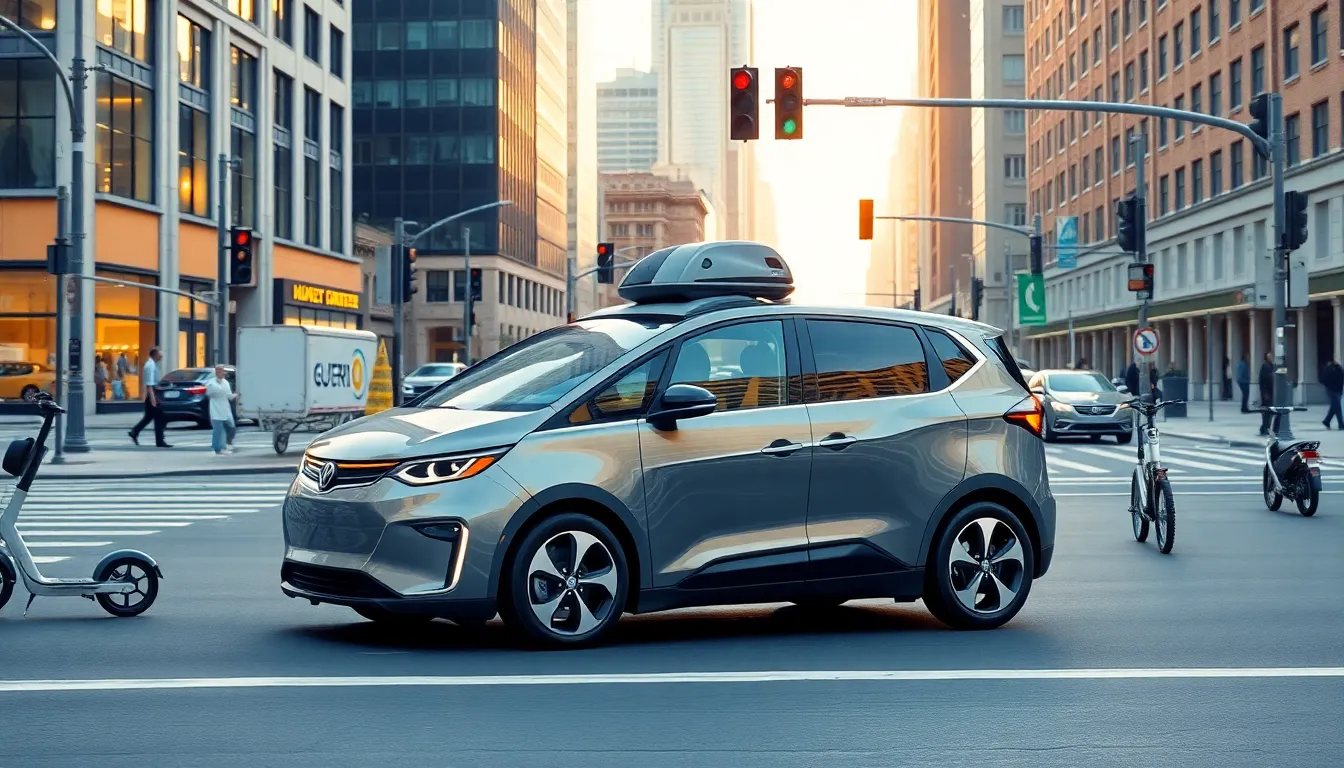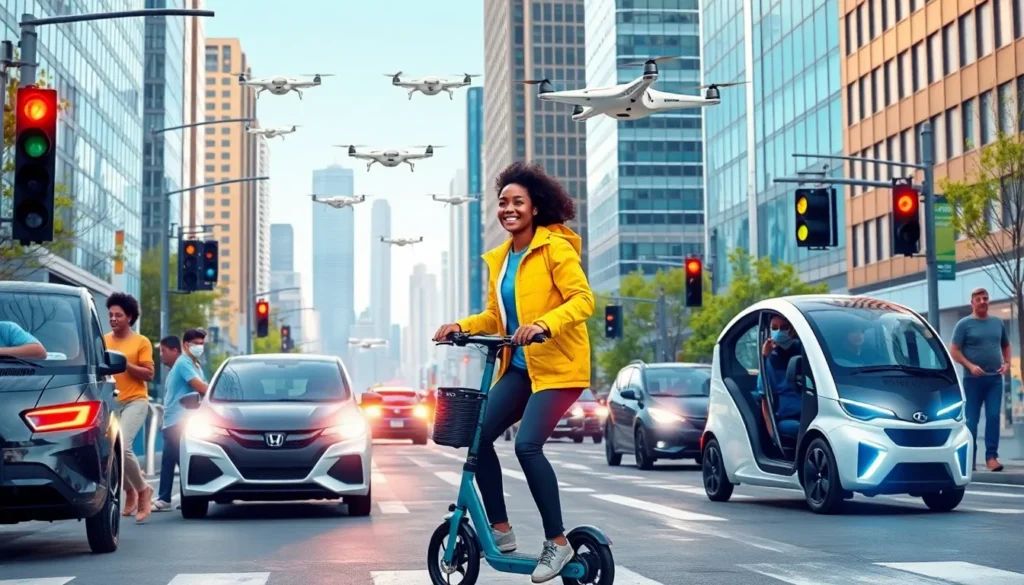Table of Contents
ToggleIn a world where traffic jams feel like a competitive sport and public transport can feel like an extreme survival challenge, transportation tech is here to save the day. Imagine a future where your car drives itself while you kick back with a latte, or where drones deliver your pizza faster than you can say “extra cheese.” It’s not just a dream; it’s happening now, and it’s changing the way we move.
Overview of Transportation Tech
Transportation technology is transforming mobility. Innovations like self-driving vehicles and drone deliveries are becoming everyday realities. Significant advancements have emerged in electric vehicles, enhancing sustainability while reducing emissions. Companies are investing in autonomous systems, making travel safer and more efficient.
Infrastructure is evolving with smart traffic lights and vehicle-to-infrastructure communication. These developments optimize traffic flow and reduce congestion. Public transportation is also benefiting from tech, with apps providing real-time information on schedules and vehicle locations.
Logistics and delivery systems leverage technology to streamline operations. Companies utilize automated warehousing and last-mile delivery solutions to improve efficiency. Drones and autonomous vehicles enable swift deliveries, making online shopping more convenient.
Data analytics plays a crucial role in improving transportation systems. By analyzing traffic patterns, agencies can implement better urban planning. Predictive maintenance for vehicles ensures safety and reduces downtime, enhancing overall service quality.
Personal mobility devices, such as e-scooters and e-bikes, are gaining popularity in urban areas. Users benefit from options that ease travel and reduce reliance on traditional vehicles. Shared mobility services, like ride-hailing apps, provide flexibility and cost-effectiveness.
Future developments in transportation tech include advancements in artificial intelligence, virtual reality, and electric flying taxis. These innovations aim to further revolutionize how society thinks about mobility. The integration of various technologies ensures continued growth and improvement in transportation systems.
Key Innovations in Transportation Tech

Transportation technology is experiencing rapid innovations that reshape mobility. Key advancements are transforming how people and goods move.
Autonomous Vehicles
Autonomous vehicles lead the charge in transportation tech. These self-driving cars utilize advanced sensors and AI to navigate safely. Companies like Waymo and Tesla are already testing these vehicles on public roads. Trials show that these innovations can reduce traffic accidents caused by human error. Regulations are evolving to accommodate these changes, fostering wider acceptance. Adoption rates may increase as infrastructure improves to support this technology.
Electric Mobility Solutions
Electric mobility solutions provide a sustainable alternative to traditional vehicles. Electric vehicles (EVs) emit no tailpipe emissions, promoting environmental conservation. Major manufacturers like Ford and Volkswagen invest heavily in EV production, expanding available models. Charging infrastructure is growing, with over 100,000 charging stations in the U.S. alone, easing range anxiety for drivers. Additionally, e-scooters and e-bikes are gaining traction, offering last-mile connectivity in urban settings. These solutions appeal to eco-conscious consumers, driving market growth.
Smart Traffic Management Systems
Smart traffic management systems enhance urban mobility. Intelligent traffic signals and IoT connectivity optimize traffic flow, reducing congestion. Cities like Los Angeles have implemented such systems, leading to smoother commutes. Real-time data analytics inform adjustments based on current traffic conditions. Furthermore, vehicle-to-infrastructure communication facilitates better coordination between vehicles and traffic systems. This innovation improves safety and efficiency on the roads, paving the way for future advancements.
Impact of Transportation Tech on Society
Transportation technology profoundly shapes modern life, influencing various aspects like economy and environment.
Economic Benefits
Cost savings emerge from innovations in transportation tech. Companies experience reduced operational expenses through automated logistics and efficient fleet management. Consumers gain access to shared mobility options, leading to significant savings on personal travel. Job creation also results from growing sectors, such as electric vehicle production and data analytics services. Enhanced delivery systems foster competition among businesses, stimulating economic growth. Increased mobility leads to higher productivity as individuals spend less time in transit. Overall, transportation tech fuels economic resilience by opening new markets and enhancing consumer access.
Environmental Considerations
Environmental sustainability stands central in transportation tech advancements. Electric vehicles contribute to reduced greenhouse gas emissions, aligning with global climate goals. Adoption of alternative energy sources strengthens efforts to combat pollution. Use of smart traffic management systems minimizes congestion, lessening fuel consumption and carbon footprints. Personal mobility devices, like e-scooters and e-bikes, further decrease reliance on traditional vehicles, promoting greener urban environments. Continuous developments in technology encourage eco-friendly practices, encouraging businesses and consumers to prioritize sustainability in transportation choices. Ultimately, transportation tech represents a pivotal force driving environmental awareness and action.
Future Trends in Transportation Tech
Transformative innovations in transportation tech are set to reshape mobility in the coming years. Key advancements blend technology with sustainable practices.
Integration with AI and Big Data
Artificial intelligence and big data integration plays a crucial role in future transportation systems. Companies leverage AI for traffic prediction models that enhance routing efficiency. Smart algorithms analyze extensive traffic datasets to identify patterns, minimizing congestion. Real-time adjustments to public transport schedules increase reliability and passenger satisfaction. Vehicle-to-everything communication enhances safety by sharing crucial information between vehicles and infrastructure. This synergy ensures smoother traffic flow and reduces travel time, ultimately improving user experiences.
Hyperloop and Advanced Rail Systems
Hyperloop technology represents a groundbreaking shift in high-speed travel. Proposed speeds can reach up to 760 miles per hour through vacuum-sealed tubes, drastically reducing travel times between major cities. Advanced rail systems also see upgrades that include magnetic levitation and automated operations for heightened efficiency. These innovations will accommodate increased passenger capacities while minimizing energy consumption. Countries like the United States and China invest in developing and testing these systems, aiming to create a network that transforms intercity travel. Enhanced rail connectivity guarantees a faster and more efficient alternative to traditional transportation methods.
Transportation tech is undeniably shaping the future of mobility. As innovations continue to emerge they promise to enhance efficiency and sustainability in travel and logistics. The integration of smart systems and electric vehicles not only addresses pressing urban challenges but also contributes to a greener planet.
With ongoing advancements in AI and data analytics the potential for improved traffic management and safety is immense. This evolution in transportation is set to create new economic opportunities while transforming everyday experiences for consumers.
As society embraces these changes the journey towards smarter and more efficient transportation systems is just beginning. The future looks bright for those ready to adapt and innovate in this dynamic landscape.







